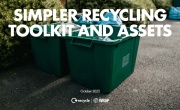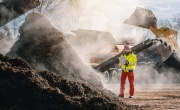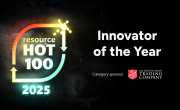How AI recycling technology can transform the circular economy
In the ever-evolving landscape of waste management technology, artificial intelligence (AI) is powering a new generation of recycling robots in materials recovery facilities (MRFs) and opening the possibility of new applications to sort recyclable materials.

The use of AI in waste management makes it possible to effectively identify materials within mixed waste streams and direct robotics to automatically separate recyclables.
Through the implementation of computer-vision and machine learning, MRFs are now able to sort waste streams with increased efficiency and precision, with AI systems identifying and sorting items by material, colour and brand, and to continually improve by learning as they go. This capability to catalogue materials is also helping with reporting and transparency in waste management through the data this technology provides.
Commenting on this potential, Claire Shrewsbury, Director Insights and Innovation at WRAP said: “We believe that improved sorting infrastructure is a real enabler in the recycling space. The amazing thing about AI-based sorting technology is that, with the right development, it can ‘learn’ anything.”
“The adoption of AI is still in its infancy but there are a number of trials and early adopters of the technology with positive results.”
“It would be incredible if, for something like WEEE, AI could learn what critical materials are contained within the WEEE. This would really help to improve the value of any sorted stream. We know that the sorting of textiles is also a challenge so it would be good for AI to develop in this space.
Rise of the recycling robots
London-based AI and robotics company Recycleye provides an integrated AI-vision and robotic picking system designed to enhance the sorting of dry mixed recyclables in MRFs. The company currently has 30 AI-powered robots contracted across the UK and Ireland, 19 of which are already installed, as well as more installed elsewhere across Europe.
Benedetta Delfino, Recycleye’s Machine Learning Tech Lead, explains how the technology achieves this: “The system can see everything that a human eye can, since it leverages image-based recognition rather than light-based, so the models can be taught to detect to the same granularity as a human eye.
“The system is programmed with a machine learning model that is tailored to the line and the categories that the plant manager wants to sort into, and is based on a sample of the line’s waste, fortified by our large database of 1.6 billion waste images.”
Their system possesses the capacity to process up to 60 images per second and recognise an unlimited number of waste material classes.
Until the application of computer-vision, established sorting technology in MRFs would use light-based recognition identifying materials by the resulting wavelength, intensity or reflection (for instance through the use of near-infrared).
To sort the recycling line, AI technology is reliant on machine learning, whereby the system continuously teaches itself to identify different materials with increased precision over time.
Commenting on the process of machine learning, Delfino says: “AI (or Deep Learning) uses thousands of factors captured by computer vision to describe or identify an item, meaning it can learn and deliver object-based detection.
“The more images the model is fed, the more accurate it becomes, so as the system scans more items on a particular line, the model will refine and detect the classes more accurately.”
Though reliant on human input to begin with – the AI must first be trained by humans originally before teaching itself – the technology possesses the ability to eventually remove humans from the sorting line.
This might be a welcome development given the occupational hazards associated with the job, notes data-expert Tom Passmore, Chief Information Officer of Dsposal. He adds: “Whilst at the moment well-trained, experienced humans will be better able to identify and classify a wider variety of materials, it's not a great job.
“As AI can be used 24/7 and is constantly learning, it's likely that it won't take long for AI to outperform humans in this way. But that is with the caveat that the AI needs good quality data to train it, and at the moment that means well-informed human intervention.”
What materials are AI systems best suited to identify and sort?
AI systems have so far seen significant success sorting dry mixed recycling at MRFs in the UK. According to Phil Longhurst, Professor of Environment and Energy Technology at Cranfield University, this is because the materials are easier to recognise: “Dry recyclables are generally free from food and moisture both of which significantly affect the surface properties of wastes”, which he adds “impacts on the ability to achieve high reliability in identification”.
Moving beyond the current success with dry recyclables, there also exists scope in the future to expand the use of AI to tackle other problematic waste streams. Speaking on the possibility of this, Longhurst adds: “There is significant scope to extend AI to all areas of waste separation, as well as dismantling. However, this will continue to both rely on and be enhanced by improved collection and separation at source.”
How AI can be developed to achieve this expansion to cover other waste streams remains a central question for the waste industry. Indeed, Recycleye is currently expanding the application of its systems to other materials, as Delfino explains: “Our AI computer vision technology can also be applied to other materials, currently, we are also applying it to Waste Electrical and Electronic Equipment, but it has the potential to be applied to limitless classes, such as construction and demolition.“
Application to new material requires adaptations of the system to suit the individual needs of the waste stream. Delfino notes that this is made possible by integrating our AI with air jets, as well as robots, to move materials into different sorting routes.
“AI-powered airjets are used to sort WEEE as well as potentially waste streams in C&D, metals and organics facilities – both to replace manual sorting and to complement existing Near Infra-Red in bulk sorting. This technology involves requiring the in-feed to provide appropriate spread of material, usually 10 per cent belt coverage, which may involve a vibrating plate being used prior to the air jet system.
“We use AI-powered air jets for higher volume sorting, which requires more speed as well as accuracy.
“Airjets can perform greater than 1000 ejections per minute, while the 6-axis robot does very targeted positive or negative sorting at up to 50 picks per minute. Hence, for lines with high throughput which require bulk sorting, which is what we usually see in WEEE and C&D streams, an AI-powered airjet is the more efficient solution.”
Improved waste data for the circular economy

Currently, spot sampling examines just one per cent or less of the material processed within MRFs, while AI has the capability to analyse the entirety of the material – ensuring a thorough and comprehensive assessment.
A greater understanding of the composition and purity of an MRF’s waste stream – permitted by AI systems – therefore allows for an improved ability to accurately price gate fees for secondary materials and assist the transition to a circular economy.
Speaking on the benefits of AI to automate waste data recording, Passmore observes: “There's huge potential here to improve reporting of waste stream composition from MRFs.
“Having comprehensive and accurate waste composition data is vital; it permits greater insight in informing policy decisions, whilst also enabling operators to demonstrate the quality of their secondary materials to potential buyers and establish a price based on purity.”
This suggests there might be scope for pricing of gate fees to be calibrated to contamination. However, introducing this technology adds to the overall operational spend for a MRF and would need to be recouped in calibrated pricing, explains Stuart Hayward-Higham, Chief Technical Development and Innovation Officer at Suez.
This will incur more cost in gathering the data, as well as applying robotics and AI. However, he notes ‘the better composition you have, the better you can value the weight of the commodities, and then you should be able to target pricing’.
“So those that have got poor quality material or low-value material [input material] will pay relatively more than those who've got high quality, high-value material because the revenue from the back end compensates the front end.
“The outcome of that is a more targeted pricing regime, because we will be looking at the quality and composition of the incoming materials in more granular detail and pricing accordingly.”
This is of particular importance to MRFs with Extended Producer Responsibility (EPR) on the horizon, bringing in more stringent recovery and audit requirements within the UK.
Claire Shrewsbury added: ”With increased requirements for sampling in MRFs, we certainly see that AI technology can play its role in not only helping to increase the quantity of data but also the insights of that data in potentially real-time, in-line sampling.
“It will be important to have protocols agreed for sampling to ensure that AI is delivering the right data which can be verified.”
How accessible is AI recycling technology to the UK waste management sector today?
One of the chief concerns surrounding the implementation of AI systems within the waste management sector is with regard to the current state of its accessibility – namely concerning its costs and ease of use.
However, most AI-robotic systems can be retrofitted over existing belts during downtime, keeping installation costs low. And, the computer-vision technology is frequently a plug and play system.
In the long-term, AI systems are expected to provide a reduction in costs and an increase in the accuracy and efficiency of picking. Rather than operating in shifts, the systems can function around the clock. Their implementation also supports MRFs in relieving the high labour turnover currently experienced within manual picking positions.
In terms of return on investment (ROI) for MRFs installing AI technology, according to Delfino, Recycleye has received positive feedback from clients: “ROI depends on the line being automated and what is required, but our clients have seen payback periods of as little as two years.”
What does the future hold for AI recycling technology?
At present, the primary frontier for AI in waste management lies in elevating the value of recyclates, positioning them as competitive alternatives to virgin materials. This marks a significant stride towards sustainability and resource efficiency.
However, to widen the scope of computer vision applications to other waste streams will mean training the AI models.
“AI needs lots and lots of data to work efficiently,” says Hayward-Higham. “If you don't have good quality data points, or if we don't have many data points, then it is a child still learning and needs lots more input.”
“I think the thing that the sector – throughout all the streams whether it's residual, commercial, hazardous, WEEE or small batteries – lacks at the moment is quality data over lengthy periods of time, which is the base of which you would start to train your AI.”
Despite this, should the implementation of AI recycling technology be able to avoid its potential pitfalls (e.g. poor quality data, high costs, difficulty of use), it has the ability to wholly transform the sector and drive the transition to the circular economy. Integrating artificial intelligence into waste management, in areas such as sorting WEEE, could be a significant advance. If AI could accurately identify and categorise the critical materials present in WEEE, it would greatly enhance the efficiency and value of the recycling process.
Additionally, the sorting of textiles remains a complex task, and the development of AI solutions in this area could lead to more effective recycling strategies. As Shrewsbury acknowledges: “It feels like the possibilities for AI could be widespread, but it does need to be linked with how items would actually be separated.”
Noting that MRF regulations scheduled for October 2024 will place a new burden on MRFs, she identifies the potential for computer vision AI to bridge the gap: “Work also needs to be done with regulators to recognise the value of the data that this type of technology can generate and how it could offer a much less onerous route to sampling.”
Currently, there are obstacles to wider adoption of AI-sorting technologies in many areas of the circular economy, but in the space of a few years these have already got a solid commercial foothold in MRFs. To leverage this recycling technology elsewhere may require a rethink in sorting lines, to enable computer-vision systems to efficiently see and act.






